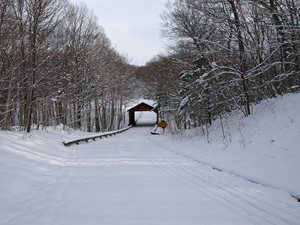Winter is here and the temperatures are dropping. Our experienced crew members already know what they need to do to keep warm, but if you're new to tree trimming and outdoor winter work, here are a few tips to help you keep warm as the weather gets cold.
Before we start, you should understand how heat actually moves. First, heat always transfers from a warm source to a cold source/area through one of three processes: conduction, convection, and radiant.
Conduction heat transfers by physical contact (touching a hot surface);
convection is warm air rising (hot air balloons and steam); and
radiant heat travels over a distance (the sun, electric heaters).
When you lose body heat, you're losing
radiant heat. That is, heat is radiating off your body. It's not rising (convection), and you're not losing it through physical contact (conduction) unless you're sitting on a cold surface. And if you can remember that principle, you can understand how to keep warm when you're working outside.

The goal is to keep heat from radiating off you, as well as to keep your core temperature up by helping your body to produce heat. Here are five tips to stay warm this winter, the first of which is insulating your body against heat loss.
1. Dress in layers. Dressing in layers is much more effective than only wearing a couple bulky items. It might work if you're taking the dog out or making the thee-mile trek across the mall parking lot, but when you're spending 8 – 10 hours outside you need the separate layers and the air layers between them. We recommend at least a t-shirt, long sleeve t-shirt, heavy work shirt, and then a sweatshirt and outdoor work jacket. This gives you more mobility and flexibility than just a long shirt and heavy work coat. Plus, dressing in several layers will let you regulate your temperature as you need it. Get a little chilly? Put on another layer. Warming up in the sun? Strip off a thin layer or two.
2. Be sure to eat throughout the day. Food is the fuel that keeps you moving and warm, and your body will burn a lot more of it up when it's cold outside. That means you'll get colder sooner as your fuel is used up faster. Carry a couple energy bars or pieces of fruit so you can have a snack during break times to keep your energy up. Warm food is also a help. Carry soup or coffee in a thermos and keep it out of the coldest part of the day. The warming drink or food will not only warm you up, but you can have it later in the afternoon when you might need a boost in your core body temp.
3. Never eat snow when you're thirsty. Ditto drinking cold water when you get warmed up. Your body uses energy to melt snow and warm up cold beverages, which lowers your body temperature. If you're trying to keep warm, this is the last thing you want to do. We've discussed the importance of staying hydrated in the past, but don't drink the same thing in the winter that you do in the summer — warmer beverages are always better than cold ones. Avoid ice water and keep your water bottles in your pockets or in your vehicles, out of the cold weather.
4. Wear a hat. First of all,
it's a myth that you lose 40 – 45% of your body heat through your head. If that were the case, we could all wear hats and skip the jackets altogether. But that doesn't mean you don't lose heat through your head. You still lose a lot of heat if your head is uncovered. Wear a thin ski cap if you can fit it under your personal protective gear. While it may not be the thick knit toque favored by many people in the frigid north, a thin ski cap can still keep you fairly warm.
5. Don't sit on anything cold. Remember what we said about conductive heat loss? That if you're touching a warm surface, heat will transfer to the cooler surface. When you're sitting on the ground or a metal tailgate during break times, you lose body heat because
you're the warm surface and your body heat is transferring into the cold tailgate.
You can sit safely and comfortably if you have some insulation between you and your seated surface, like a coat or even a folded-up blanket. Otherwise, you'll lose heat quickly, no matter how warmly you're dressed or how much food you eat.
The Midwest can get pretty cold starting in December, and depending on where you live, it can stay colder much longer than March and April, so it's important to do everything you can to keep warm. Not only does it let you work in comfort, it helps you keep safe and focused on your work.
Photo credit: Skeeze (Pixabay, Creative Commons 0)